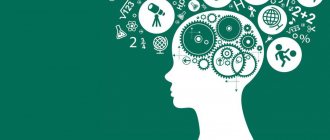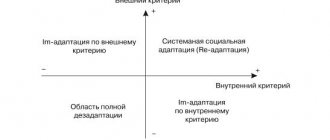World of Psychology
Psyche is a property of highly organized living matter, which consists in the subject’s active reflection of the objective world, in the subject’s construction of a picture of this world and the regulation of behavior and activity on this basis.
Nature and mechanisms:
- psyche is a property only of living matter. Moreover, not just living matter, but highly organized living matter. Not all living matter has this property, but only that which has specific organs that make it possible for the psyche to exist.
- The main feature of the psyche is the ability to reflect the objective world, i.e. highly organized living matter, possessing a psyche, has the ability to obtain information about the world around it.
- living matter with a psyche is capable of responding to changes in the external environment or to the influence of environmental objects.
Irritability is a certain property that distinguishes living matter from nonliving matter. Outwardly it is expressed in the manifestation of forced activity of a living organism (observed already in the simplest organisms - amoeba and even in plants, the so-called “tropism” - forced movement).
Sensitivity is a more complex form of response, combining the more complex anatomical structure of a living organism and its response to a complex set of environmental factors. According to Leontiev, the appearance of sensitivity in animals can serve as an objective biological sign of the emergence of the psyche. Characterizes the general ability to sense.
Behavior is a complex set of reactions of a living organism to the influence of the external environment. Living beings, depending on the level of mental development, have behaviors of varying complexity. The most complex behavior is observed in humans, who, unlike animals, have not only the ability to respond to sudden changes in environmental conditions, but also the ability to form motivated (conscious) and purposeful behavior. The ability to carry out such complex behavior is due to the presence of consciousness in humans.
Consciousness is the highest level of mental reflection and regulation, inherent only to man as a socio-historical being. From a practical point of view, consciousness appears as a continuously changing set of sensory and mental images that directly appear before the subject in his inner world and anticipate his practical activity. Humans are distinguished from animals by the mechanisms of consciousness that arose in the process of human social development. As a result of the action of mechanisms, a person distinguishes himself from the environment and forms his “I-concept” and criticality.
Functions of the psyche: most authors identify 2 main functions of the psyche:
- reflection function, promoting knowledge of the surrounding world;
- The function is regulatory, giving the opportunity to regulate one’s actions and behavior.
- function of maintaining the integrity of the body (Maklakov).
The functions are interconnected and are elements of the integrative function of the psyche, which is to ensure the adaptation of a living organism to environmental conditions.
Stages of mental development: Leontiev A.N. – 3 stages
- The stage of the elementary sensitive (sensory) psyche - reflects one property of an object or phenomenon that directly affects the senses (a bee flies to the smell).
- The stage of the perceptual psyche – reflects an object or phenomenon in a set of properties in the form of an image.
- Stage of intellectual behavior (elementary thinking) - the animal mentally establishes connections between objects in a given situation, but cannot reflect the situation in concepts.
Fabry, omitted the 3rd stage and proposed introducing levels (lowest, highest, highest) at the 1st and 2nd stages:
| Stages and levels of mental reflection, its characteristics | Features of behavior associated with this stage and level | Types of living beings that have reached this level of development |
| I. Stage of elementary sensory psyche | ||
| A. Lowest level. Primitive elements of sensitivity. Developed irritability | A. Clear reactions to biologically significant properties of the environment through changes in speed and direction of movement. Elementary forms of movement. Weak plasticity of behavior. Unformed ability to respond to biologically neutral, devoid of vital significance properties of the environment. Weak, unfocused motor activity | A. Protozoa. Many lower multicellular organisms living in aquatic environments |
| B. Highest level. The presence of sensations. The appearance of the most important organ of manipulation - the jaws. Ability to form elementary conditioned reflexes | B. Clear reactions to biological neutral stimuli. Developed motor activity (crawling, digging in the ground, swimming with exit from the water to land). The ability to avoid environmental conditions, get away from them, and actively search for positive stimuli. Individual experience and learning play a small role. Rigid innate programs are of primary importance in behavior. | B. Higher (annelid) worms, gastropods (snails), some other invertebrates |
| II. Perceptual psyche stage | ||
| A. Low level. Reflection of external reality in the form of images of objects. Integration, unification of influencing properties into a holistic image of a thing. The main organ of manipulation is the jaws | A. Formation of motor skills. Rigid, genetically programmed components predominate. Motor abilities are very complex and varied (diving, crawling, walking, running, jumping, climbing, flying, etc.). Active search for positive stimuli, avoidance of negative (harmful) ones, developed defensive behavior | A. Fish and other lower vertebrates, as well as (to some extent) some higher invertebrates (arthropods and cephalopods). Insects. |
| B. Highest level. Elementary forms of thinking (problem solving). Developing a certain “picture of the world” | B. Highly developed instinctive forms of behavior. Learning ability | B. Higher vertebrates (birds and some mammals) |
| B. The highest level. Identification of a special, indicative, research, preparatory phase in practical activities. The ability to solve the same problem using different methods. Transferring the once found principle for solving a problem to new conditions. Creation and use of primitive tools. The ability to understand the surrounding reality, regardless of existing biological needs. Direct consideration and consideration of cause-and-effect relationships between phenomena in practical actions (insight) | B. Identification of specialized organs of manipulation: paws and arms. Development of research behaviors with extensive use of previously acquired knowledge, skills and abilities | B. Monkeys, some other higher vertebrates (dogs, dolphins) |
Origin of the psyche
At all stages of the development of science, the mental processes of living beings actively manifested themselves, which led to their evolution into a more complex form inherent in humans. The first mention of the psyche in ancient philosophy dates back to the period of the 4th–5th centuries. BC e. For a long time, the system of views of this concept developed within the framework of philosophy, religion and natural science.
In psychology, scientific directions were formed only at the end of the 19th - beginning of the 20th centuries. Combined into holistic theoretical approaches, they defined the concept of the psyche, its similarities and differences between humans and animals.
Human consciousness
The relationship between the human psyche and consciousness is a special phenomenon, which is characterized by a high level of abstract logical thinking, interaction with the environment, speech, forecasting events, introspection and self-control.
Man is a biological species that, in the process of phylogenesis, has created a complex indirect system between itself and the environment. Consciousness is the highest form of reflection of reality, a set of mental processes that allow a person to navigate the world around him. It is also the ability to think, reason and evaluate one’s attitude to reality.
Mental function is formed on the basis of three types of information:
- sensory - coming from the outside world;
- obtained from memory;
- extracted from motivation centers.
In the first case, consciousness is connected with the outside world, in the second it is a combination of the past, present and personal experience of the subject. In the third option, satisfaction of needs gives life meaning to consciousness.
Structural representation
In psychology, there are three large groups of psychological phenomena that make up the structure of the psyche: mental states, processes and properties.
A mental process is a phenomenon manifested in the form of a reaction, which has a beginning, development and ending. Irritations come from both external sources and the internal environment of the body.
Mental processes are divided into cognitive, emotional and volitional:
- The cognitive category includes thinking, perception, memory, sensation, speech, imagination.
- Emotional ones include feelings of lower and higher order, mood, state of stress, frustration, affect.
- Volitional qualities determine consciously set goals, accepted intentions, attitudes, needs, and motives.
Mental states are stable phenomena caused by the impact of events in internal and external life on a person. The individual is usually aware only of the condition, and the factor that caused it is not clearly defined.
There are states:
- General - vivacity, joy, apathy, anxiety, interest, activity, relaxation, etc.
- Emotional - anger, sadness, irritability, joy.
- The creative state is inspiration.
- States of frustration, affect.
- A person’s life position: needs, interests, beliefs, ideals. All these phenomena determine the level of human activity.
- Temperament type is the natural qualities of a person. Balanced, agile, slow, strong.
- Character traits - belief system, behavior, etc.
Mental properties are a feature inherent in people. Stable phenomena determine the qualitative and quantitative level of life activity and are characteristic of a particular person.
The characteristics of mental properties are presented in several directions:
A person’s mental education is the characteristics acquired by an individual in the process of professional and life experience. A person is characterized by several manifestations: knowledge, skills, abilities, habits, views, attitudes, beliefs.
Highly organized matter
The nervous system is a complex, living structure made up of billions of elements. In the process of biological evolution, a change in the structure of connections between elements led to the formation of a unique organ capable of not only perceiving the surrounding world, but also coordinating the actions of other organs that influence the existence of the organism.
These processes include: breathing, vision, hearing, reproduction, movement. The nervous system is also capable of organizing, retrieving, and storing information about past experiences as needed. An equally important ability is to anticipate changes in life conditions.
A high level of organization of the nervous system is manifested in the ability for self-development and evolution. The development of an individual occurs from birth to death. In the mind of an individual, the image of the world is not just a decoration with unfolding life events. An individual approach and selectivity are manifested in the behavior with which the carrier satisfies needs.









